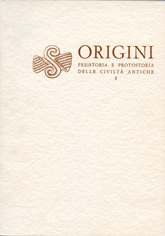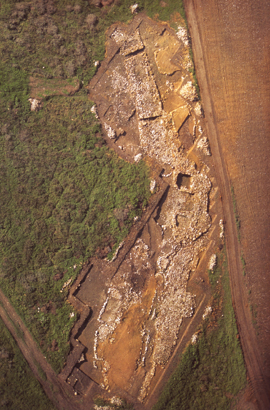
The numerous lines of research conducted by Puglisi led him to explore a vast range of cultural and chronological contexts and countries. Each one was inspired by the academic's profound interest in cultural transformation processes and the study of the interaction between the natural and social environment. His main work, La Civiltà Appenninica (Apennine Civilisation), 1959, is an exemplary demonstration of his thoughts and work method, characterised by: great attention to the reconstruction of "biogeographic" environments, economic data, settlement models, the functioning of manufactured items, the use of influences from other disciplines, such as ethnology, anthropology, ecology, history of religion. A truly unique work which became a model for generations of academics of Italian palethnology.
In Italy his activities led him to conduct research in the regions of Sardinia, Lombardy, Marche, Lazio, Abruzzo and Apulia. He carried out numerous excavations. Of particular significance are those of Conelle di Arcevia, in Marche, and Coppa Nevigata in Apulia.
Abroad, his research focused on the Near East and North Africa: in Turkey he launched the excavation of the tell of Arslantepe, near Malatya, where he explored the Hittite and neo-Hittite settlement phases, up to proto-urban developments dating back to the end of the 4th millennium. In Egypt, the excavation of the proto-dynastic site of Maadi enabled Puglisi to conduct an in-depth analysis of the urbanisation process, whereas his investigations in the upper Nile area in Sudan and the Libyan Sahara focused on the study of Epipaleolithic hunter-gatherer societies and later pastoral groups.
The scientific activity of Salvatore Puglisi also includes the foundation of the journalOrigini.Preistoria e Protostoria delle Civiltà Antiche in 1967.
the Journal Origini

The journal Origini. Preistoria e Protostoria delle Civiltà Antiche which was the fulfilment of a long-held dream. He had studied the format, cover, fonts and layout with great attention and passion.
Puglisi aimed for a scientific initiative, fuelled by passion and which, in accordance with the intentions of its founder, represented an alternative to other Italian specialist magazines of the time.
 Its programmes and objectives are expressed in the presentation of the first edition which was published in 1967: the subtitle Preistoria e Protostoria delle Civiltà Antiche (Prehistory and Protohistory of Ancient Civilisations) highlighted and aimed to inspire "the study of the formation of ancient civilisations and not only the documentation of cultural moments and situations which pre-date history". Therefore, he was interested in the formation and organisation processes of culture, using all tools available in order to capture the "uninterrupted progress of a cultural phylum". The systematic nature of documentation, the perfect interdisciplinarity reflected in the contribution of specialists from various disciplines, forged a homogeneous and articulated work, in accordance with the premise explained by Puglisi himself upon creating the magazine.
Its programmes and objectives are expressed in the presentation of the first edition which was published in 1967: the subtitle Preistoria e Protostoria delle Civiltà Antiche (Prehistory and Protohistory of Ancient Civilisations) highlighted and aimed to inspire "the study of the formation of ancient civilisations and not only the documentation of cultural moments and situations which pre-date history". Therefore, he was interested in the formation and organisation processes of culture, using all tools available in order to capture the "uninterrupted progress of a cultural phylum". The systematic nature of documentation, the perfect interdisciplinarity reflected in the contribution of specialists from various disciplines, forged a homogeneous and articulated work, in accordance with the premise explained by Puglisi himself upon creating the magazine.
COPPA NEVIGATA (Foggia-Puglia)

Quagliati Excavations 1904-5; Mosso 1909; Puglisi 1955, 1967, 1971-73, 1975; Cassano, Manfredini 1983; Manfredini 1986,1991; Cazzella, from 1983.
The site, which consists of a high plane near an ancient coastal lagoon, with a stratigraphy of over 4 metres, is characterised by occupation from the Neolithic up to the First Iron Age.
With reference to the ancient Neolithic, a ditch with engraved ceramics and microlithic industry has been identified. There are typical small flint points which were probably used to open shells. Based on recent C14 analyses, the site can be dated back to the earlier centuries of the 6th millennium, in calibrated chronology.
Puglisi excavations brought to light a fortified residential area from the Bronze Age, the oldest testimonies of the remains of a residential structure, datable back to the Proto-Apennine (beginning of the 2nd millennium BC). A first defence wall was completed during the following period, over 5 metres thick, with an opening of 70 cm, delimited by large stones. During the early phase of the Apennine the wall lost its function; nearby there are traces of burials and a kiln.
Later excavations, which have lasted several decades and are still in progress, led to the discovery and a better understanding of the settlement's articulated development, which lasted approximately a millennium.
Throughout the entire Bronze Age, subsistence activities included agriculture (cereals and legumes) and animal husbandry (cows, goats, sheep and pigs), although hunting, deer hunting in particular, acquired considerable importance during the Late Sub-Apennine.
The high plane was sporadically occupied until the first Iron Age (8th century BC).


CONELLE DI ARCEVIA (Ancona-Marche)
Puglisi excavations 1958-69.
The site of Conelle is located on an ample plane of approximately 4 hectares. It is delimited by two rivers, and its other two sides, devoid of natural defence barriers, are characterised by a ditch 100 metres in length and up to 7 metres deep. It was discovered at the end of the 19th century and was systematically studied by Puglisi between 1958 and 1969. It is a residential area of which no trace remains, due to erosion and the destructive action of agricultural works. Ditch fillings contain an important stratigraphy, indicating various moments of habitation. Materials include abundant, unrefined ceramic with applications, including typical "rosettes". Fine ware ceramics include flasks, bowls, askoid jugs, pyxis vases, transverse edge pitchers. The lthic industry is very rich: the most frequent artefacts include arrow heads, double-edged daggers and stone axe hammers. There are also numerous tools made from hard animal material, such as points and awls. There are numerous spindles, even decorated ones, indicative of weaving and spinning activities. Copper objects are very rare.


